Peace on Earth, The Large Bather, Bas-Relief Woman, Return of the Prodigal Son, and Untitled
Introduction
Text-to-speech Audio
This tour stop combines five works which are all situated in the courtyard at the southeast corner of the museum building. First, Peace on Earth by Jacques Lipchitz (1969) is a spiritual work inspired by the rediscovery of Judaism after the artist fled Paris during WWII. Just north a few feet, the next sculpture is The Large Bather by Pierre Auguste Renoir (1917-18), who played a critical role in French Impressionism as a painter but did not start sculpting until his last few years of life. Located on the museum’s south wall, Bas Relief Woman by Gaston Lachaise (1934) reveres the artist's wife, love of his life, and life-long muse, Isabel, as a strong and confident woman. Looking left, Return of the Prodigal Son is a second sculpture by Jacques Lipchitz (1931) which depicts an emotional embrace between two abstract figures. The final work in this courtyard is a minimalistic human form in motion, called Untitled by Joel Shapiro (1991).
Images
Peace on Earth by Jacques Lipchitz at the Nelson-Atkins Museum of Art, Kansas City, Missouri.
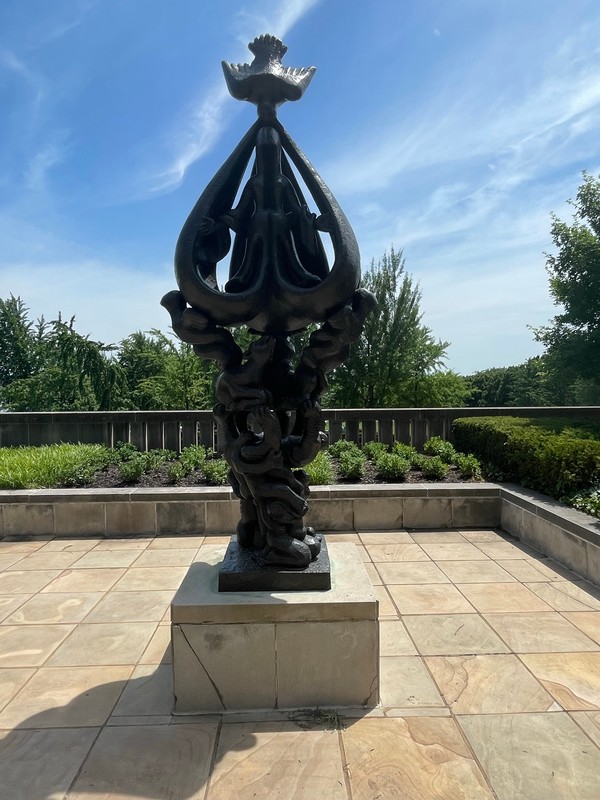
Peace on Earth by Jacques Lipchitz

Jacques Lipchitz (1891-1973), artist of Peace on Earth and Return of the Prodigal Son

The Large Bather (also known as The Washerwoman) by Pierre Auguste Renoir at the Nelson-Atkins Museum of Art, Kansas City, Missouri.
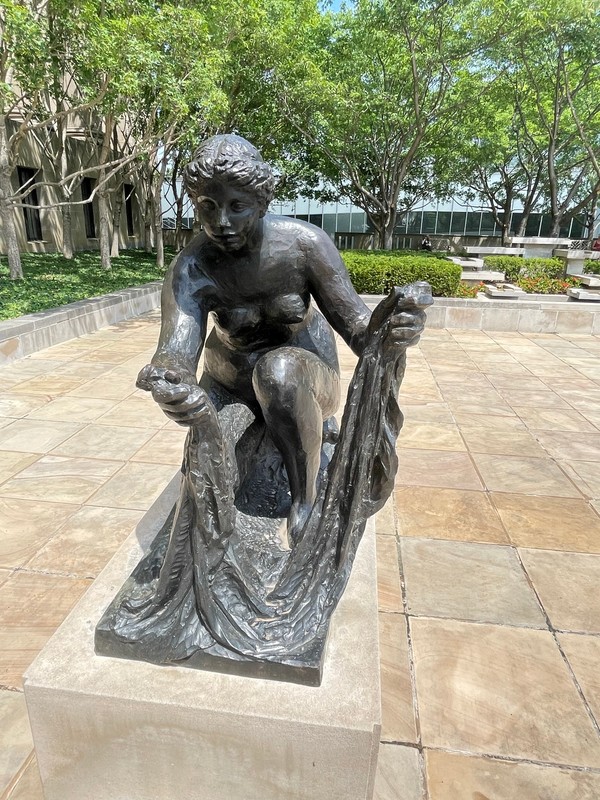
Pierre Auguste Renoir (1841–1919), artist of The Large Bather
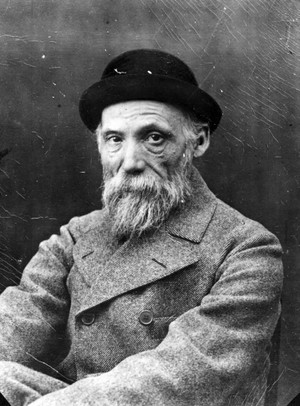
Bas-Relief Woman by Gaston Lachaise at the Nelson-Atkins Museum of Art, Kansas City, Missouri.
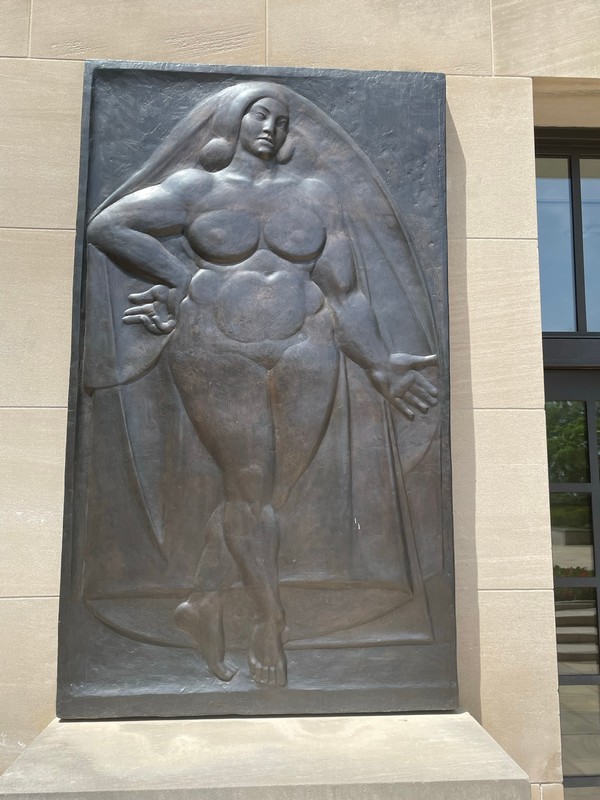
Gaston Lachaise (1882-1935), artist of Bas-Relief Woman. Photo by Paul Strand, credit to the National Portrait Gallery, Smithsonian Institution.
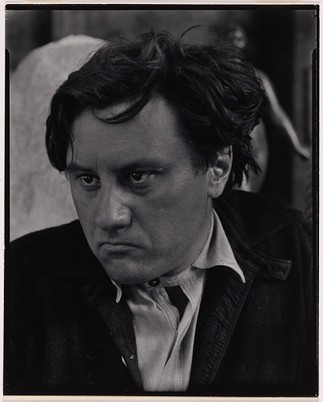
Return of the Prodigal Son by Jacques Lipchitz at the Nelson-Atkins Museum of Art, Kansas City, Missouri.

Return of the Prodigal Son, side view
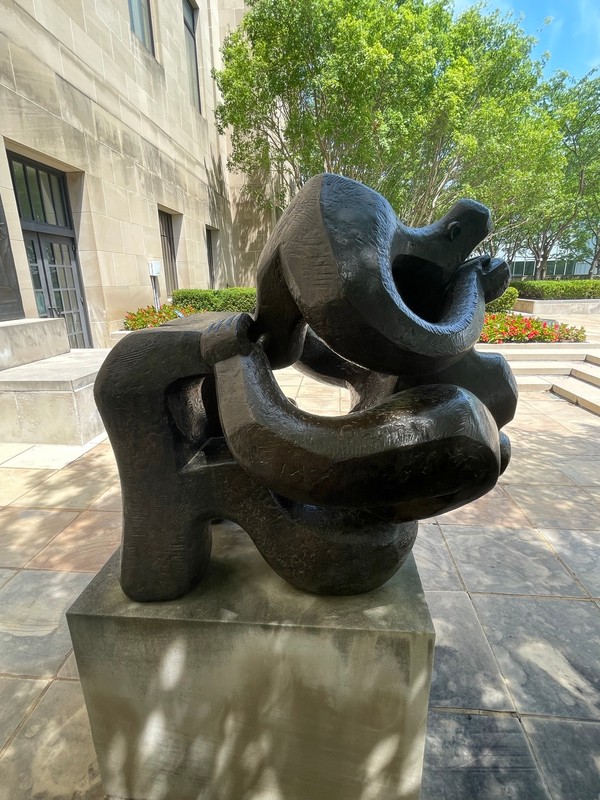
Untitled (1991) by Joel Shapiro at the Nelson-Atkins Museum of Art, Kansas City, Missouri.
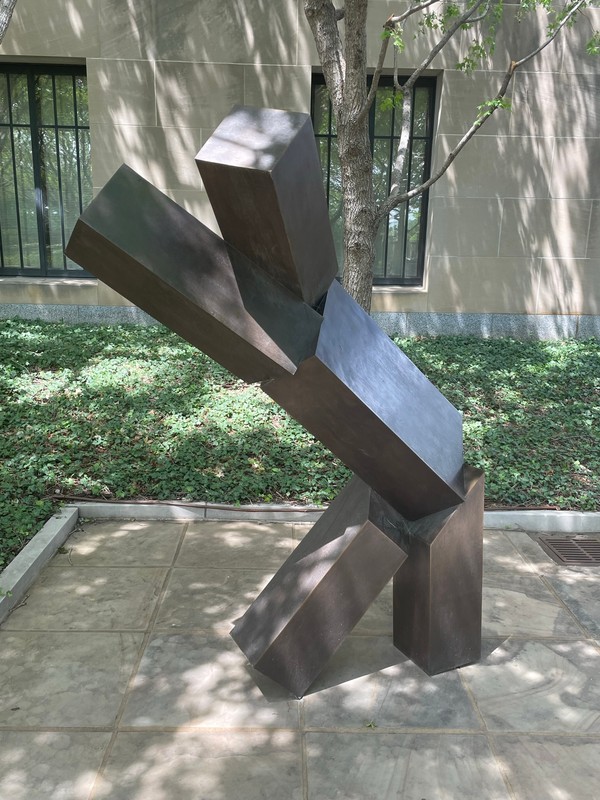
Joel Shapiro (1941- ), artist of Untitled
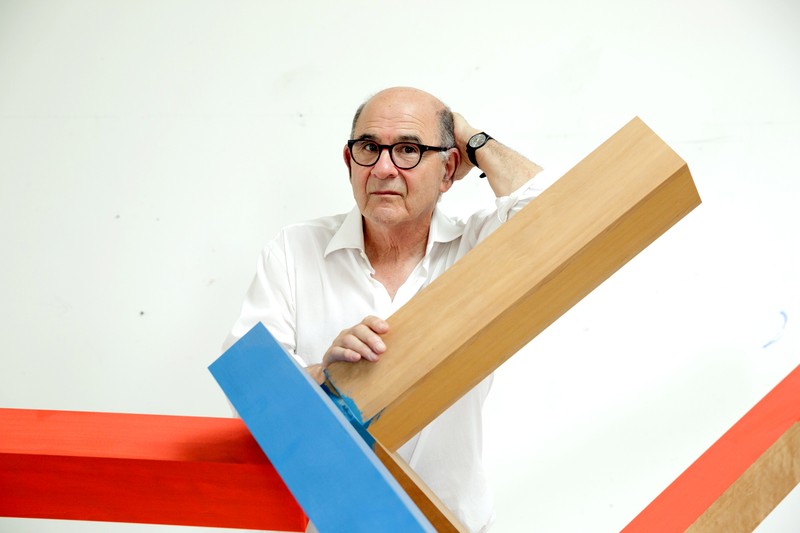
Backstory and Context
Text-to-speech Audio
Peace On Earth
Jacques Lipchitz (1891-1973) is best known for his contributions to and transformative work in Cubism in the early twentieth century. Born to a Jewish family in a small Russian-ruled town in modern-day Lithuania as Chaim Jacob Lipchitz, he studied engineering for a short time at a state high school until he moved to Paris in 1909 to pursue the arts. There, he assumed the name Jacques and enrolled at the École des Beaux-Art and Academie Julian. In a time when avante garde was flourishing in Paris, Lipchitz became friends with some of the most notable artists and began transforming the characteristics from Cubist paintings into sculpture.
Lipchitz’s work began to move towards a more figurative style in the 20s. He started incorporating negative space which allowed viewers to see through the sculptures, classifying them as “Transparents.” By 1930 he became publicly known and was exhibiting internationally. However, due to his Jewish heritage upon the onset of World War II and the Nazi invasion into Paris in 1940, he fled to the United States, landing in New York. The horrific acts being inflicted on the Jewish people led Jacques to rediscover his religion and spirituality, which is clearly exhibited in his later works.
Peace on Earth was created in 1969 and evokes Lipchitz’ emotional, spiritual expression. The ten-foot tall bronze depicts prima materia at the base which then transforms upwards into the Lamb of God, angels, and the Virgin Mary, who is encapsulated by a tear-shaped canopy. The sculpture culminates with a dove, the universal symbol for peace. The work was donated by the Elmer F. Pierson Foundation and was originally part of the E.F. Pierson Sculpture Garden dedicated in 1972, then renovated and merged with the Kansas City Sculpture Park in 2006 before becoming Donald J. Hall Sculpture Park in 2014.
Gallery Label Description
“Peace on Earth incorporates themes and motifs that Lipchitz had been exploring for 20 years. The knotted masses at the base represent prima materia, the raw matter from which all things emerge. Progressing upward are depicted: the Lamb of God, angels, the Virgin Mary and ultimately the Holy Spirit, in the traditional form of a dove. Peace on Earth is an optimistic work expressing the transformation of flesh into spirit. Its broader, underlying theme of metamorphosis occupied Lipchitz throughout his career.”
The Large Bather
Less known for his sculpting, Pierre Auguste Renoir (1841–1919) was a central figure of the early French Impressionist movement in the mid-nineteenth century as a painter. As a boy he developed an early talent for drawing and worked painting designs on fine china at a porcelain factory. He started studying and exhibiting paintings in the 1860s and by the 80s, his techniques moved from colorful portrayals of real life scenarios and landscapes to more formal, figurative work and portraiture, particularly of women.
Nearing the turn of the century, Renoir developed rheumatoid arthritis, eventually developing deformities in his hands and becoming wheelchair-bound. Into the 1900s, he painted with brushes tied to his fingers and used moving canvases to aid in his work, but also started sculpting during this period. Due to his limited mobility, he recruited assistants to model the clay, in which he would supply drawings of his ideas. For The Large Bather, he employed Richard Guino.
Similar to his earlier Impressionistic paintings of bathing women, this bronze was sculpted from 1917-18. Also known as La Laveuse, The Washerwoman, and The Large Stooping Washerwoman, The Larger Bather was originally planned to be part of a complimenting pair symbolizing fire and water, featuring a Blacksmith heating iron on a stove and a washerwoman rinsing the laundry. However, the former was never completed due to growing tensions between Renoir and Guino. Multiple small models of the washerwoman were created to explore variations of the position of her arms and hands before attempting on a larger scale, but at the time of Guino’s separation in December 1918, the 4-foot sculpture was still in a rough phase and finished at a later time.
The Larger Bather was purchased in 1977 from the Galerie Andrée Stassart in Paris by the Elmer F. Pierson Foundation for the Nelson-Atkins Museum of Art.
Gallery Label Description
“Renoir is famous as one of the great Impressionist painters, but he is less well known as a sculptor. Late in life, when he was crippled with arthritis, he produced some 24 sculptures including this impressive work. Also known as The Washerwoman, it represents a nude lifting her laundry from the water. The rugged, bronze surfaces, in contrast to the polish of academic sculpture, can be related to the “sketchiness” of Impressionism. Due to his disability, the sculpture was made under Renoir’s strict direction by his talented assistant, Richard Guino.”
Bas-Relief Woman
Playing a critical role in the shaping of American Modernism, Gaston Lachaise (1882-1935) is best known for his nude female figures. Lachaise was born in Paris and lived there until 1905. After studying art in his early teens, he was accepted to the Academie Nationale des Beaux-Arts at age 17 where he began showing annually at their official art exhibition Salon, quickly gaining recognition. Around 1903 he met the love of his life, Isabel Nagel, who was the reason he left for the United States in 1905, later became his wife and was the primary inspiration for his work.
The model for Bas Relief Woman was created over a nine year period, starting in 1925. Lachaise resumed the work in 1934, with the final figure being more voluptuous than preliminary forms. The full-figured woman stands on her tip-toes with one hand on her hip and the other to her side with an open palm, articulated curves, and a veil draped over her head. Referring to her as “Woman” throughout his works, the woman depicted is Lachaise’s wife Isabel, who he referred to as “majestic” and “the Goddess I am seeking to express in all things."
Also called Relief (Woman), the plaster mold was shown in Lachaise’s 1935 retrospective at the Museum of Modern Art but not cast, however, until decades later when the Lachaise Foundation issued a series of eight on behalf of the artist’s estate. The present form was the second cast (1993) and was purchased by the William Rockhill Nelson Trust through the George H. and Elizabeth O. Davis Fund.
Gallery Label Description
“Bas Relief Woman is Gaston Lachaise's elegant homage to Isabel, his wife and life-long model. Here he presents his beloved as he saw her: a voluptuous earth mother overflowing with cosmic energy. Serenely confident and strong, she gracefully extends her left hand while balancing effortlessly on her toes. Lachaise refines the sinuous curves and proportions of his muse in this highly stylized bronze relief.”
Return of the Prodigal Son
Originally working in the Cubist style, Jacques Lipchitz turned from geometric shapes to more figurative forms in the 1920s. This new work removed obvious details of the subject while delineating softer lines and negative space throughout the sculpture. He classified these works as “Transparents” as viewers can see through the openings in the piece.
One of Lipchitz’s earlier Transparent works, Return of the Prodigal Son was sculpted in 1931. This nearly 4-foot sculpture depicts two abstract human figures, the top figure appearing to lean over the other in an emotional embrace. While the title of this allegorical sculpture seems to allude to a biblical reference, given the definition of “prodigal son,” a boy who leaves home without the approval of his family but later makes a repentant return, another possible denotation is perhaps a personal reference to Lipchitz’s own experience.
Born to a successful building contractor in a small, Litvak town under Russian rule (modern-day Lithuania), Jacques' father Abraham insisted that he study engineering. His mother, however, encouraged him to study the arts and sent him to Paris in 1909 without his fathers knowledge. Though he originally disapproved, Abraham eventually accepted the decision, but a few years later he developed tuberculosis and could no longer work to support Jacques’ endeavors. Lipchitz stated, "after I went to Paris, my father forgave me and as long as he was able to, he contributed to my support.” Abraham passed away in 1928, and though possibly harboring feelings of guilt due to leaving his family years earlier, Jacques stayed in Paris until 1940 when he fled to the United States during WWII.
Return of the Prodigal Son was a gift of Mrs. R. C. Kemper Sr. through the R. C. Kemper Charitable Trust.
Gallery Label Description
“Jacques Lipchitz's Return of the Prodigal Son retains a disciplined angularity derived from his early investigation of Cubism. It dates, however, from a later phase in his career, when he was occupied with organic forms and themes related to the human condition. Return of the Prodigal Son was Lipchitz's first interpretation of a biblical subject.”
Untitled
New York artist Joel Shapiro (1941- ) is known for exploring configuration in space, taking influence from both Minimalism and Modernism. He uses blocks of wood to create simple, geometrically figurative sculptures, often depicting the body in motion. His work ranges in scale and orientation, sometimes being suspended from the wall or ceiling, and uses a variety of colors. He stated, "I am interested in those moments when it appears that it is a figure and other moments when it looks like a bunch of wood stuck together—moments when it simultaneously configures and disfigures."
One of many works named Untitled, Shapiro allows the viewer to interpret the movement based on their own thoughts and experiences, and perhaps to explore the movement with their own body without influence. He created the present, 6-and-a-half-foot sculpture in 1991 and cast it in bronze the following year. The first major outdoor exhibition of Shapiro’s bronze, Joel Shapiro: Outdoors, included this work and was co-exhibited by the Nelson-Atkins Museum of Art with the Walker Art Center of Minneapolis in 1995-96.
Untitled (1991) was purchased by the Hall Family Foundation in 1992 and gifted to The Nelson in 1999.
Gallery Label Description
“The simple, geometric forms of Joel Shapiro's sculpture suggest the human body in motion. Untitled appears from certain views to have two upraised arms and one leg extended, as though taking a bow or preparing to do a cartwheel. Its open forms activate the surrounding space and invite the viewer to strike a similar pose.”
Sources
Peace on Earth, The Nelson-Atkins Museum of Art. Accessed September 27th, 2022. https://art.nelson-atkins.org/objects/29873/peace-on-earth.
Jacques Lipchitz, The Art Story. Accessed September 27th, 2022. https://www.theartstory.org/artist/lipchitz-jacques/.
The Editors of Encyclopaedia Britannica. "Nelson-Atkins Museum of Art". Encyclopedia Britannica, 13 Dec. 2021, https://www.britannica.com/topic/Nelson-Atkins-Museum-of-Art. Accessed 27 September 2022.
The Large Bather, The Nelson-Atkins Museum of Art. Accessed September 27th, 2022. https://art.nelson-atkins.org/objects/11650/the-large-bather.
Biography of Pierre Auguste Renoir, Pierre Auguste Renoir. Accessed September 27th, 2022. https://www.pierre-auguste-renoir.org/biography.html.
The Washerwoman, Tate. Accessed September 27th, 2022. https://www.tate.org.uk/art/artworks/renoir-the-washerwoman-n05933.
Bas-Relief Woman, The Nelson-Atkins Museum of Art. Accessed September 27th, 2022. https://art.nelson-atkins.org/objects/145/basrelief-woman.
Biography , Lachaise Foundation. Accessed September 27th, 2022. https://www.lachaisefoundation.org/biography/.
Friedlander, Sara. Gaston Lachaise (1882-1935), Relief (Woman) [LF 128], Christie's. Accessed September 27th, 2022. https://www.christies.com/en/lot/lot-6169017.
Return of the Prodigal Son, The Nelson-Atkins Museum of Art. Accessed September 27th, 2022. https://art.nelson-atkins.org/objects/1343/return-of-the-prodigal-son.
"Jacques Lipchitz, Sculptor, 81, Dead." The New York Times Archives, May 28th, 1973. Page 1. https://www.nytimes.com/1973/05/28/archives/jacques-lipchitz-sculptor-81-dead-jacques-lipchitz-sculptor-dead.html.
Abraham-Itzhok Shayevich Lipchitz, Geni. Accessed September 27th, 2022. https://www.geni.com/people/Abraham-Itzhok-Lipchitz/6000000015370859266.
Untitled, The Nelson-Atkins Museum of Art. Accessed September 27th, 2022. https://art.nelson-atkins.org/objects/11782/untitled.
Untitled, The Metropolitan Museum of Art. Accessed September 27th, 2022. https://www.metmuseum.org/art/collection/search/492432.
Joel Shapiro Biography, Berggruen Gallery. Accessed September 27th, 2022. https://www.berggruen.com/artists/joel-shapiro/installations?view=multiple-thumbnails.
Photo by David Trowbridge
Photo by David Trowbridge
https://www.guggenheim-bilbao.eus/en/the-collection/artists/jacques-lipchitz
Photo by David Trowbridge
http://art-renoir.com/artworks/photo/Auguste%20Renoir%201900s.jpg
Photo by David Trowbridge
https://npg.si.edu/object/npg_NPG.85.31
Photo by David Trowbridge
Photo by David Trowbridge
Photo by David Trowbridge
https://www.culturedmag.com/article/2016/10/20/joel-shapiro-dominique-levy
